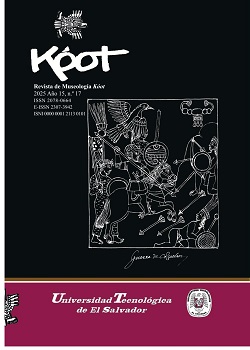Mochizalco center of nahua political and symbolic power in the salvadoran southwest
Published 2025 - 01 -01
Keywords
- Mochizalco, Ahuachapán (El Salvador)-nahuas,
- El Salvador-history-discovery and conquest, 1524,
- Itzalco site (El Salvador),
- Indigenous people of Mexico-Aztecs,
- Multiculturalism
- Nahua philosophy ...More
Copyright (c) 2025 Universidad Tecnológica de El Salvador

This work is licensed under a Creative Commons Attribution-NonCommercial-ShareAlike 4.0 International License.
How to Cite
Abstract
After five hundred years, the history of the peoples that make up the first civilizing root of what is now called El Salvador continues to be hidden by a thick darkness. The elites that have governed during the last 203 years have allowed only fragments of that becoming to come to light, either to condemn them or to use them as part of the scaffolding of a nation-state project that emerged outside of its deep past. In that scenario and from a confusing mix of liberal, conservative and authoritarian ideas, the Salvadoran intellectuals throughout the twentieth century vigorously promoted the dead indigenous, mainly immersed in the lethargy and silence of an archaeological capsule and a stoic but distant history. The inanimate “Indian,” the one who does not manifest, demand or claim, was given a fabulous past alongside foreign deities, non-existent heroes were granted to him and a kingdom called Cuscatlán was created for him. Thus, the other peoples who shared territory and history with the true Pipil settlement have been conveniently made invisible, while the other Nahua political-administrative centers that coexisted with the real Cushcatan were chained to oblivion. Among these was Mochizalco, a Nahua power center linked to an almost mythical lineage and of a multicultural nature that dominated what is now southwestern El Salvador through a configurational display, as recorded by the Tlaxcalans five centuries ago.
Keywords: Mochizalco, Ahuachapán (El Salvador)-Nahuas, El Salvador-History-Discovery and conquest, 1524, Itzalco site (El Salvador), Indigenous people of México-Aztecs, Multiculturalism, Nahua philosophy
References
- Aguilar, Y. E. (2017). Ayuujk: Apuntes sobre la tradición oral y la tradición escrita. Este País. https://anterior.estepais.com/articulo.php?id=1036&t=ayuujk-apuntes-sobre-la-tradicion-oral-y-la-tradicion-escrita
- Alvarado, P. de, García de Palacio, D. y Ponce, A. (2000). Cartas de relación y otros documentos. Dirección de Publicaciones e Impresos.
- Amaroli, P. (1991). Linderos y geografía económica de Cuscatlán, provincia pipil del territorio de El Salvador. Mesoamérica, 12(21), 41-70. https://dialnet.unirioja.es/servlet/articulo?codigo=3731266
- Barberena, S. (1914). Historia antigua y de la conquista de El Salvador. (tomo 1). Imprenta Nacional.
- Bernal García, M. y García Zambrano, A. (2006). El Altepetl colonial y sus antecedentes prehispánicos: Contexto teórico-historiográfico. En F. Fernández Chistlieb y A. J. García Zambrano (Eds.), Territorialidad y paisaje en el Altepetl del siglo XVI (pp. 31-113). Fondo de Cultura Económica.
- Brito Guadarrama, B., González Pérez, I., Sánchez Flores, R., Regueiro Suarez, P. y Pérez Zevallos, J. M. (2021). El Lienzo de Tlaxcala. Fondo de Cultura Económico.
- Chavero, A., García Quintana, J. y Martínez Marín, C. (s. f.). Lamina 10: Chalco. Reconstrucción Histórica Digital del Lienzo de Tlaxcala. https://lienzotlaxcala.wordpress.com/lamina-10/
- Cossich Vielman, M. (s. f.). La escritura jeroglífica de los nahuas. Noticonquista. https://www.noticonquista.unam.mx/sites/default/files/2020-04/cossich_-_jeroglificos_-_final.pdf
- Escalante, P. (1992). Códice de Sonsonate. (tomo 1), El Salvador, Dirección de Publicaciones e Impresos.
- Herrera Vega, A. (1961). Expresión literaria de nuestra vieja raza. Ministerio de Educación.
- Iniciativa Portadores del Náhuat - IPN El Salvador. (26 de abril de 2023). Rio Sagrado Sensunapan [publicación]. Facebook. https://acortar.link/Pz38uR
- Johansson, K. (2012). La imagen del huasteco en el espejo de la cultura náhuatl prehispánica. Estudios de Cultura Náhuatl, 44, 65-133. https://www.historicas.unam.mx/publicaciones/revistas/nahuatl/pdf/ecn44/ecn044.html
- López Bernal, C. G. (2008). Las reformas liberales en El Salvador y sus implicaciones en el poder municipal, 1871-1890. Diálogos, Revista de Historia, 9, 1770-1800. https://revistas.ucr.ac.cr/index.php/dialogos/article/view/31311
- Mazzetto, E. (2014). Tlacochcalco, “el lugar de la casa de los dardos” y la materialización del inframundo: Homologías funcionales de un espacio sagrado mexica. Studi e Materiali di Storia delle Religioni, 80(1), 226-244. https://acortar.link/TZ3UYD
- Navarrete, F. (s. f.). El altépetl. Noticonquista. http://www.noticonquista.unam.mx/amoxtli/765/744
- Navarrete Linares, F. (2019). Los orígenes de los pueblos indígenas del valle de México: Los altépetl y sus historias. Instituto de Investigaciones Históricas. https://bit.ly/3hJqpQW
- Schultze-Jena, L. (2010). Mitos en la lengua materna de los pipiles de Izalco en El Salvador. Universidad Don Bosco.
- Tous, M. (2009). Caciques y cabildos: Organización socio-política de los pueblos de indios en la alcaldía mayor de Sonsonate (s. XVI). Revista de Indias, 69(247), 63-82. https://doi.org/10.3989/revindias.2009.024
- Tous, M. (2011). Cacao y encomienda en la alcaldía mayor de Sonsonate, siglo XVI. Anuario de Estudios Americanos, 68(2), 513–537. https://doi.org/10.3989/aeamer.2011.v68.i2.548
- Van Akkeren, R. (2024). Visión indígena de la conquista. Piedrasanta.

